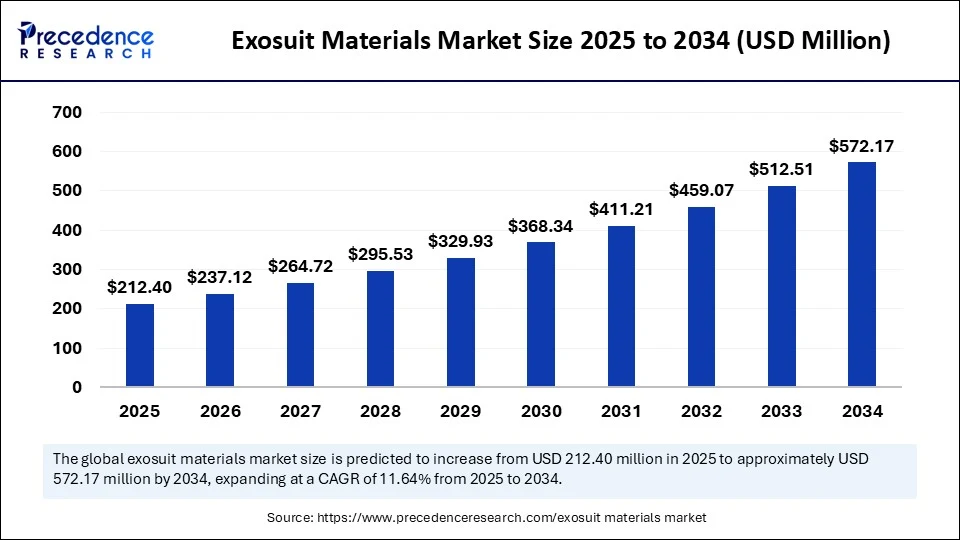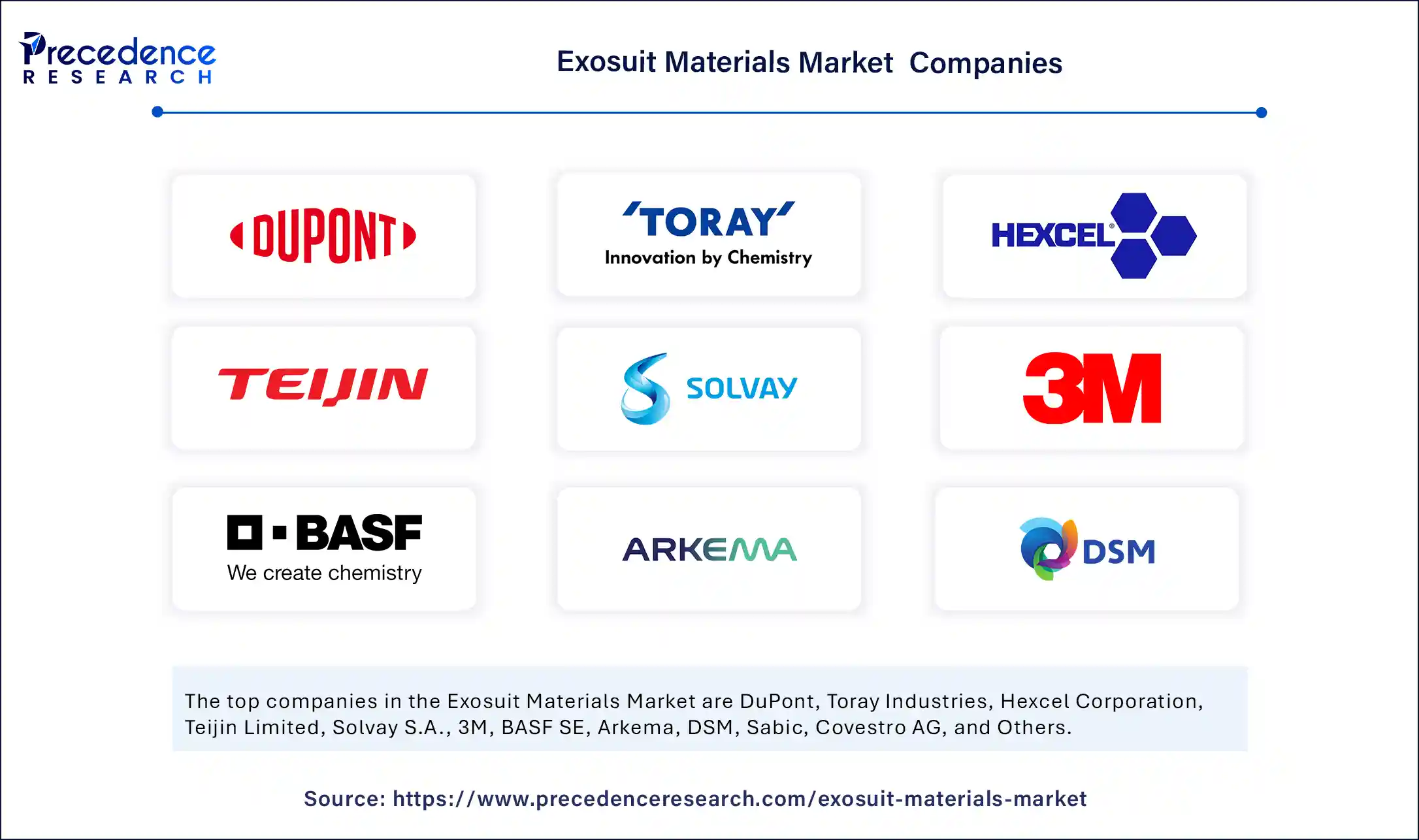The global exosuit materials market size was evaluated at USD 190 25 million in 2024 and is predicted to hit around USD 572 17 million by 2034, growing at a CAGR of 11 64%.

- The global exosuit materials market was valued at USD 190.25 million in 2024, and is projected to reach USD 572.17 million by 2034, growing at a CAGR of 11.64% from 2025 to 2034.
- North America led the market with a 37% share in 2024.
- The Asia Pacific region is expected to witness the fastest growth during the forecast period.
- By material type, soft and flexible materials held the largest share at 45% in 2024, while sensor-integrated materials are forecasted to grow at the fastest CAGR.
- By suit type, soft exosuits accounted for 53% of the market in 2024, with hybrid designs expected to experience the highest CAGR going forward.
- In terms of application, medical and rehabilitation dominated with a 49% share in 2024, whereas the industrial/occupational segment is projected to grow at the fastest pace.
- Among end-users, hospitals and rehab centers led with a 43% share in 2024, and manufacturing companies are expected to post the fastest CAGR.
What Role Does AI Play in Advanced Exosuit Materials?
Artificial intelligence is revolutionizing the exosuit materials industry by enabling more adaptable, intelligent, and efficient wearable systems. This enhances user comfort, performance, and safety, particularly in rehabilitation and healthcare. AI accelerates material innovation, allowing materials to be pre-designed for specific conditions and optimized for durability, flexibility, and weight. In addition, AI algorithms are used to design and optimize exosuit materials. They can analyze vast datasets to identify the best materials and configurations for specific applications, improving performance and reducing costs.
Market Overview
In 2024, soft and flexible materials held the largest share (45 percent), alongside soft exosuits capturing 53 percent of the market by suit type. Medical and rehabilitation applications and hospitals and rehab centers as end‑user segments were the largest contributors with 49 percent and 43 percent shares respectively. Regionally, North America led with a 37 percent share while Asia‑Pacific stood out as the fastest‑growing region expected throughout the forecast period.
Get Sample Link@ https://www.precedenceresearch.com/sample/6416
Market Drivers
-
Rising Rehabilitation Needs & Aging Populations – As populations age in North America, Europe, Japan, and parts of Asia, demand for assistive and supportive wearable devices in physical therapy and rehabilitation continues to surge. Exosuits employing soft and flexible materials provide lightweight, comfortable support for individuals recovering from injury or living with mobility impairments.
-
Industrial & Occupational Safety Mandates – Increasing regulatory emphasis on workplace ergonomics, worker injury reduction, and efficiency in heavy industries drives development of sensor‑integrated materials and hybrid suit types. Manufacturers and logistics firms are adopting exosuits to enhance worker performance and reduce musculoskeletal injuries.
-
Technological Advancements – Breakthroughs in smart textiles, flexible sensors, actuators, and miniaturized control systems have made it feasible to integrate sensors, soft actuators, and adaptive materials into lightweight exosuit designs, boosting their appeal. The sensor‑integrated materials segment is poised for rapid growth due to demand for real‑time monitoring, adaptive feedback, and closed‑loop control.
-
Government & Institutional Support – Public funding and research initiatives into assistive technologies, rehabilitation devices, and industrial automation have supported academic and commercial exosuit development. Collaboration between governments, research institutions, and industry helps accelerate material innovation.
Opportunities
-
Untapped Emerging Markets in Asia and Latin America – Although North America currently holds the largest share, regions such as APAC and Latin America remain under‑penetrated. The strong forecast CAGR in Asia Pacific suggests enormous opportunity in countries experiencing rapid industrialization, increasing healthcare infrastructure investment, and rising aging populations.
-
Cross‑Sector Adoption – Beyond medical and industrial settings, applications in military, logistics, agriculture, and sports performance enhancement represent new verticals for exosuit materials. For example, sensor‑integrated soft materials could be adopted in civil defense or field work.
-
Customization & Personalization – Advances in flexible manufacturing, modular materials, and adaptive design open doors to bespoke exosuit materials tailored to specific users—athletes, patients with unique impairments, or workers in defined occupational roles.
-
Integration with Wearable Electronics & IoT – The growth of the Internet of Things, wearable health monitoring, and digital twin ecosystems enable sensor‑rich materials to play a key role in remote monitoring, predictive maintenance, and user performance analytics.
-
Hybrid Material Innovations – Combining soft, flexible fabrics with rigid or semi‑rigid composites and sensor networks can lead to next‑generation hybrid exosuits—offering both comfort and higher mechanical assistance while retaining dexterity. Manufacturers launching these hybrid material platforms stand to gain leadership in an evolving segment.
Challenges
-
High Development & Manufacturing Costs – R&D costs for advanced sensor‑integrated textiles, actuators, and hybrid material systems are substantial. Scaling from prototypes to reliable mass‑manufactured products remains expensive and technically complex.
-
Regulatory and Certification Hurdles – Medical devices, personal protective equipment, and occupational safety gear must comply with regulatory regimes such as FDA, CE marking, ISO standards, or industrial safety certifications. Approval cycles can delay market entry.
-
Durability & Reliability Concerns – Materials that are soft, flexible, and sensor‑embedded must endure repetitive strain, abrasion, sweat, cleaning, and mechanical stress without degradation. Ensuring long‑term performance is an engineering challenge.
-
User Acceptance & Adoption Barriers – Particularly in industrial environments, users may resist wearing exosuits due to perceived discomfort, interference with mobility or productivity, or cultural reluctance. Medical patients may face concerns about comfort, skin irritation, or stigma.
-
System Complexity & Integration – Sensor‑integrated materials require robust power sources, data processing systems, and connectivity. Ensuring seamless integration with control units, actuators, and user interfaces adds complexity and risk.
Recent Developments
-
Commercial Launches of Smart Exofabric Lines – Companies have begun introducing soft actuator textiles with integrated sensors for real‑time joint angle detection and force feedback, tailored for rehabilitation and industrial assistance. These products are positioned to capture sensor‑integrated material growth.
-
Hybrid Design Exosuits in Pilot Projects – Industrial pilots in warehouses and automotive assembly plants have tested hybrid exosuits combining rigid exoskeleton elements with soft textile interfaces, aiming to enhance lifting efficiency while maintaining wearer comfort.
-
Healthcare Trials and Clinical Partnerships – Collaborations between medical device companies, hospitals, and academic research centers have initiated clinical trials using soft exosuits for gait training in post‑stroke and spinal cord injury patients. Early results report increased mobility and reduced therapy duration.
-
Government‑Backed Research Consortia in APAC – Public‑private consortia in South Korea, Japan, and China have received government grants to accelerate exosuit materials innovation, with specific focus on low‑cost, locally manufacturable fabrics and sensors to serve eldercare in aging societies.
-
Standardization Initiatives – Industry groups, research institutions, and standards bodies are working to define material testing protocols for durability, hygiene, biocompatibility, and performance metrics for sensor‑integrated exosuit elements. These aim to streamline certification and acceptance.
-
Investment & M&A Activity – Venture capital funding has surged for startups developing proprietary soft exosuit textiles, sensor‑embedded fabrics, and hybrid suit prototypes. Mergers between material science innovators and wearable robotics companies are reshaping the competitive landscape.
Exosuit Materials Market Companies

- DuPont
- Toray Industries
- Hexcel Corporation
- Teijin Limited
- Solvay S.A.
- 3M
- BASF SE
- Arkema
- DSM
- Sabic
- Covestro AG
- Owens Corning
- Parker Hannifin
- Gore Fabrics (Gore-Tex)
- Lubrizol
- Eastman Chemical Company
- E-textiles by Myant Inc.
- StretchSense Ltd.
- Xsens Technologies
- Conductive Composites Co.
Market segment Covered in the Report
By Material Type
- Soft & Flexible Materials
- Textiles (Nylon, Polyester, Kevlar)
- Elastomers (Silicone, TPU, Neoprene)
- Smart Fabrics / E-textiles
- Rigid & Structural Materials
- Carbon Fiber Composites
- High-Strength Aluminum Alloys
- Titanium Alloys
- Engineering Plastics (Polycarbonate, PEEK)
- Sensor-Integrated Materials
- Piezoelectric Materials
- Graphene-based Materials
- Liquid Metal Alloys
- Flexible Printed Circuits (FPCs)
- Energy Storage Materials
- Thin-Film Batteries
- Solid-State Batteries
- Supercapacitor Materials
By Suit Type
- Soft Exosuits
- Fabric-based actuation systems
- Pneumatic / Hydraulic textiles
- Rigid Exoskeletons
- Powered upper/lower body frames
- Passive support structures
- Hybrid Designs
- Mixed soft–rigid architectures
By Application
- Medical & Rehabilitation
- Post-stroke therapy
- Spinal cord injury
- Elderly mobility assistance
- Defense & Military
- Load carriage
- Endurance enhancement
- Injury prevention
- Industrial / Occupational
- Logistics
- Construction
- Assembly lines
- Consumer & Sports
- Mobility aid for the elderly
- Athletic enhancement (early-stage)
By End-User
- Hospitals & Rehabilitation Centers
- Defense Organizations / Military
- Manufacturing Companies
- Construction Firms
- Individuals (Home Care / Personal Use)
By Region
- North America
- Europe
- Asia Pacific
- South America
- Middle East & Africa
Also Read@ https://www.precedenceresearch.com/